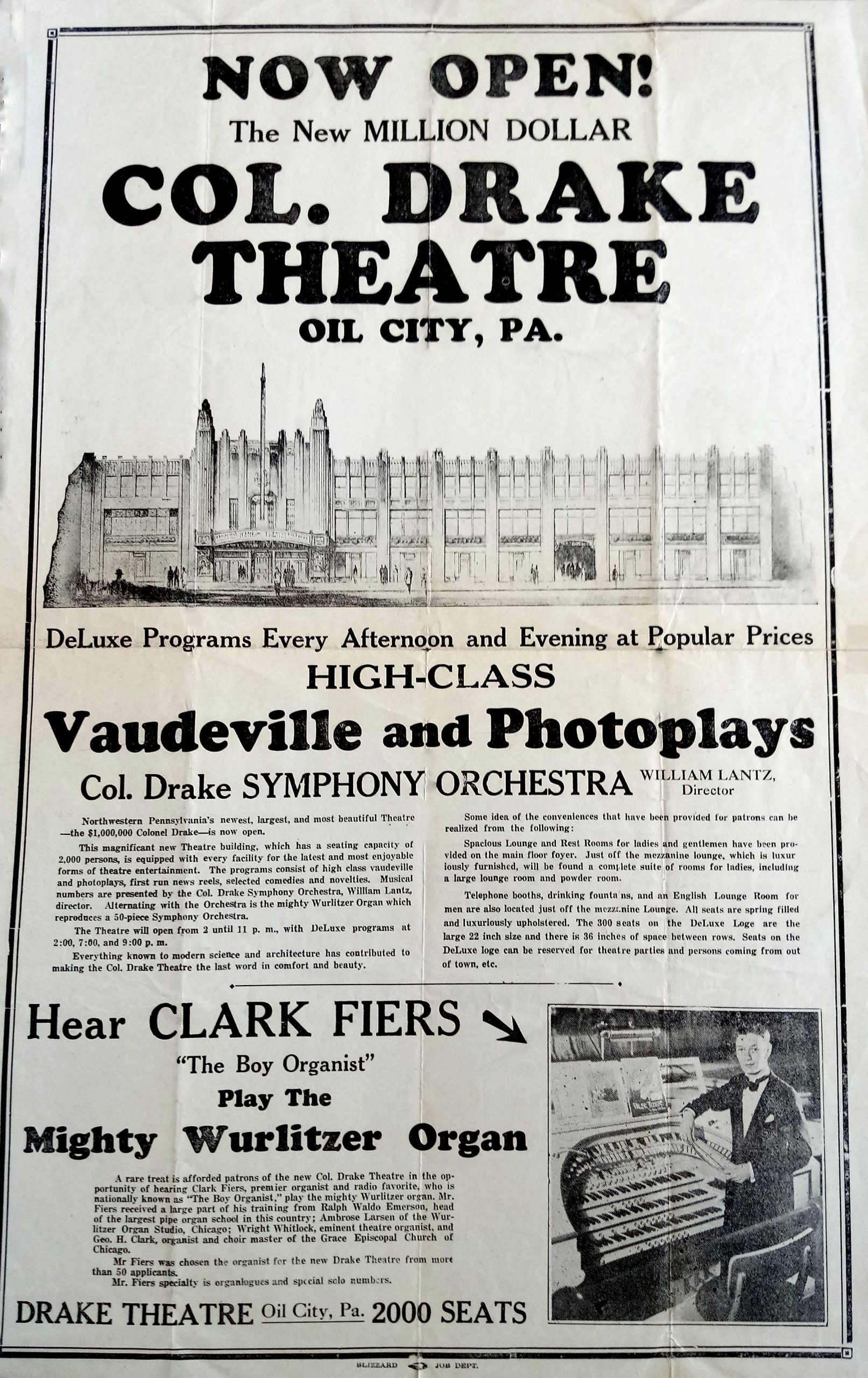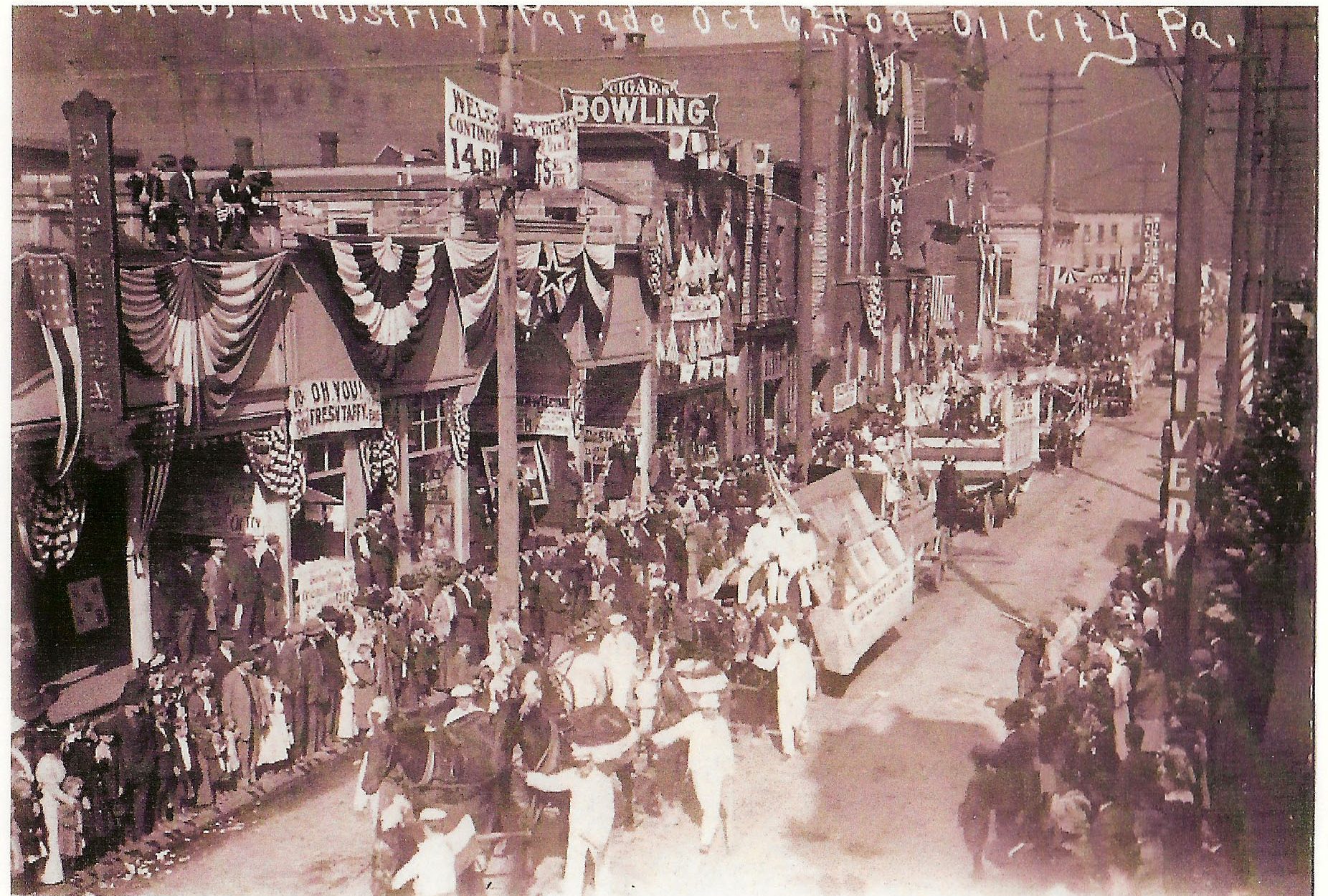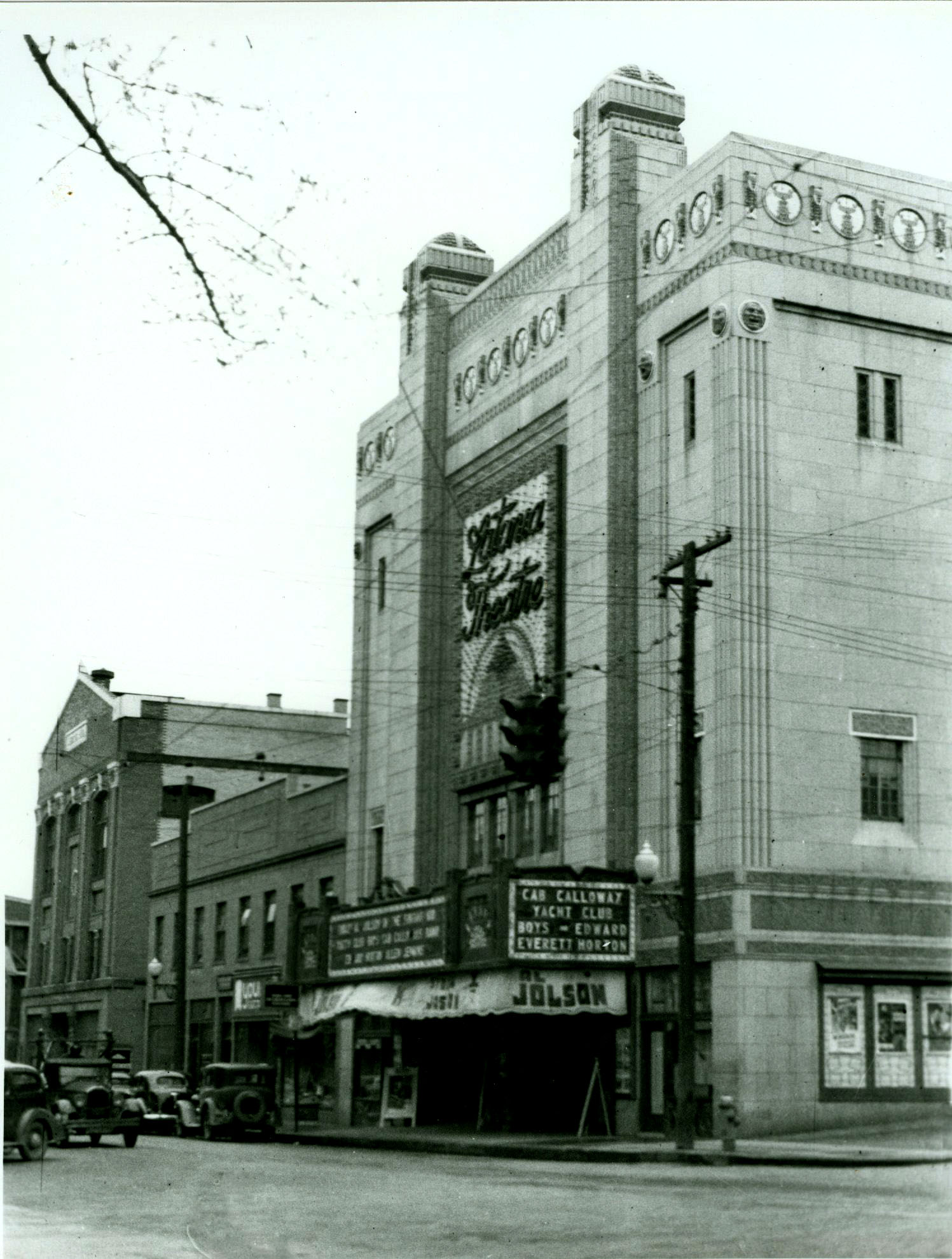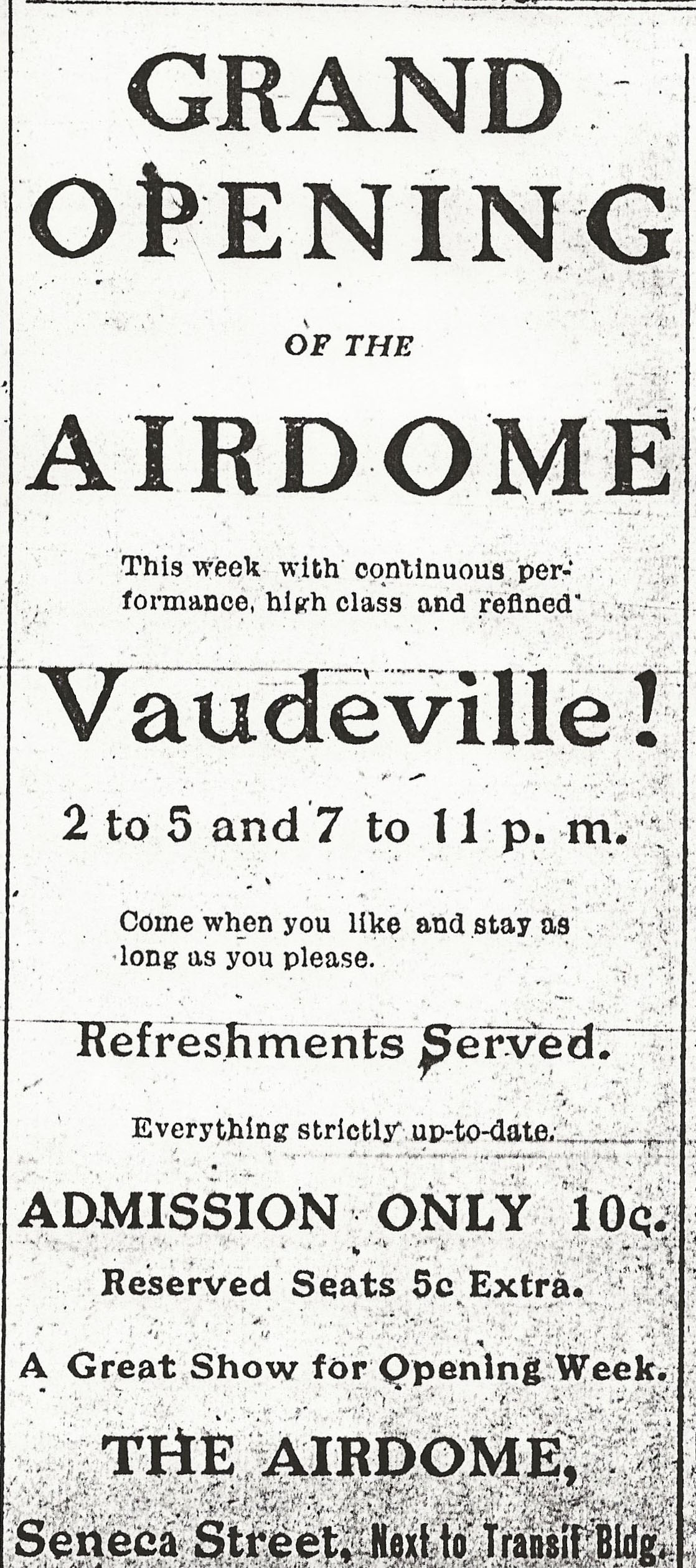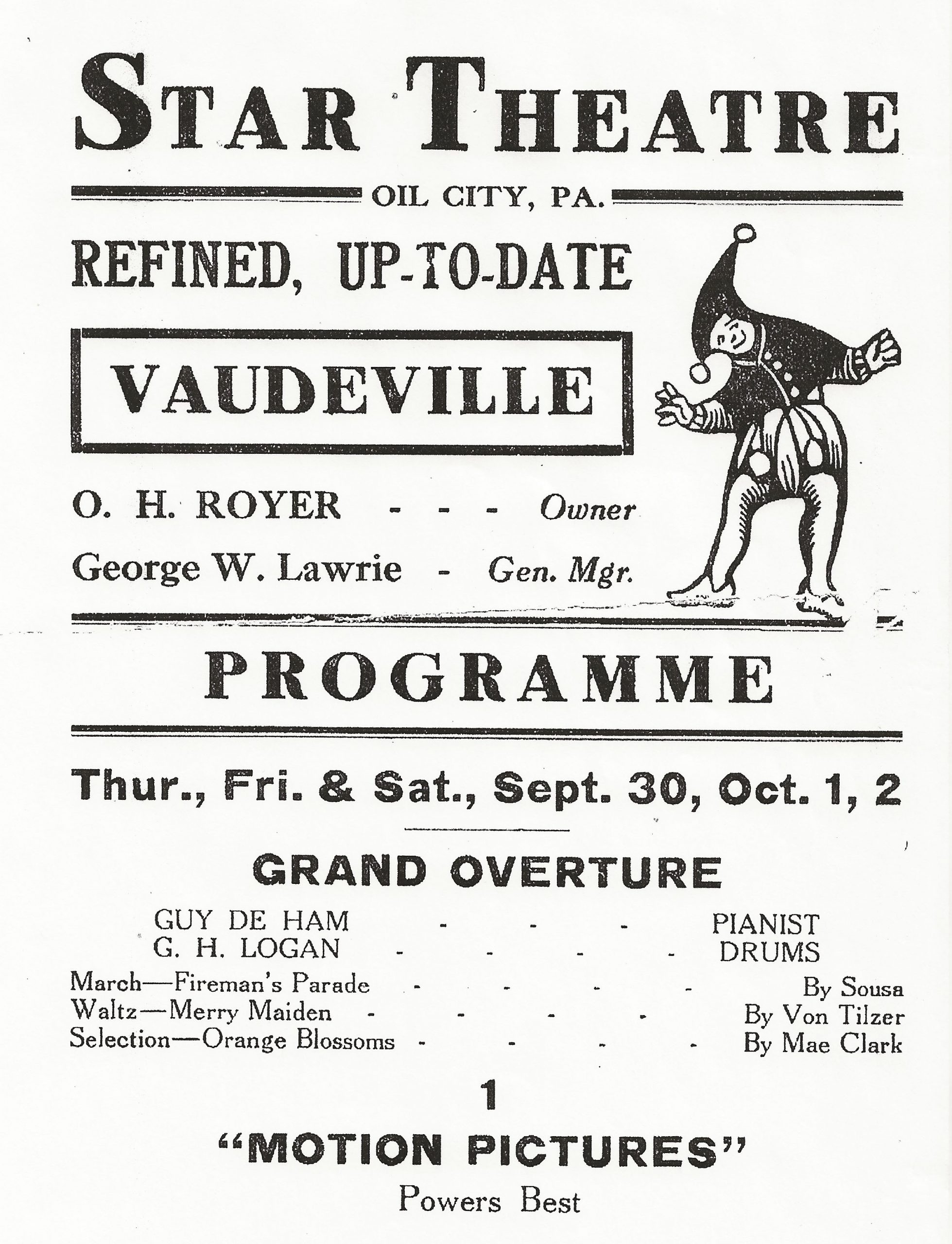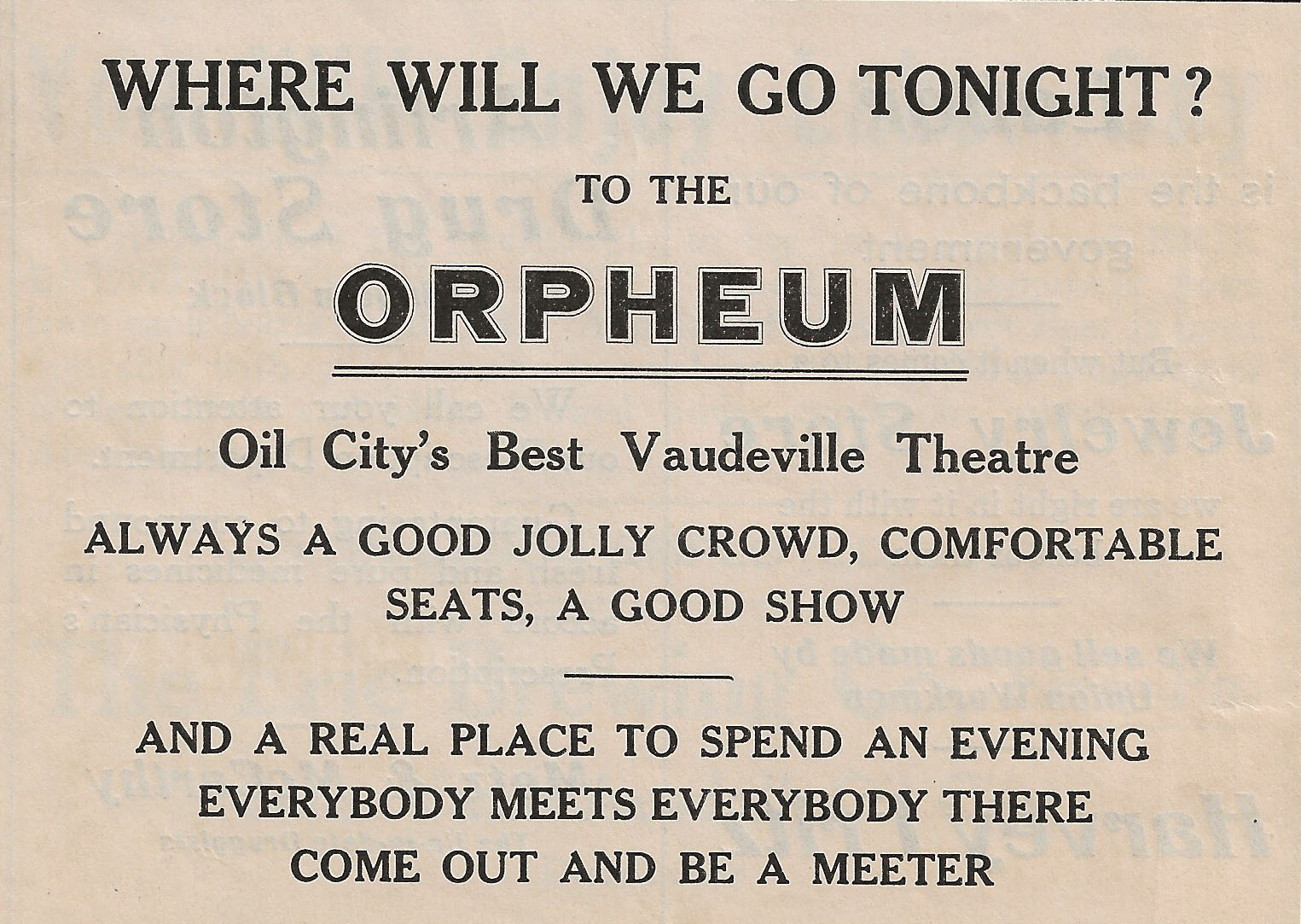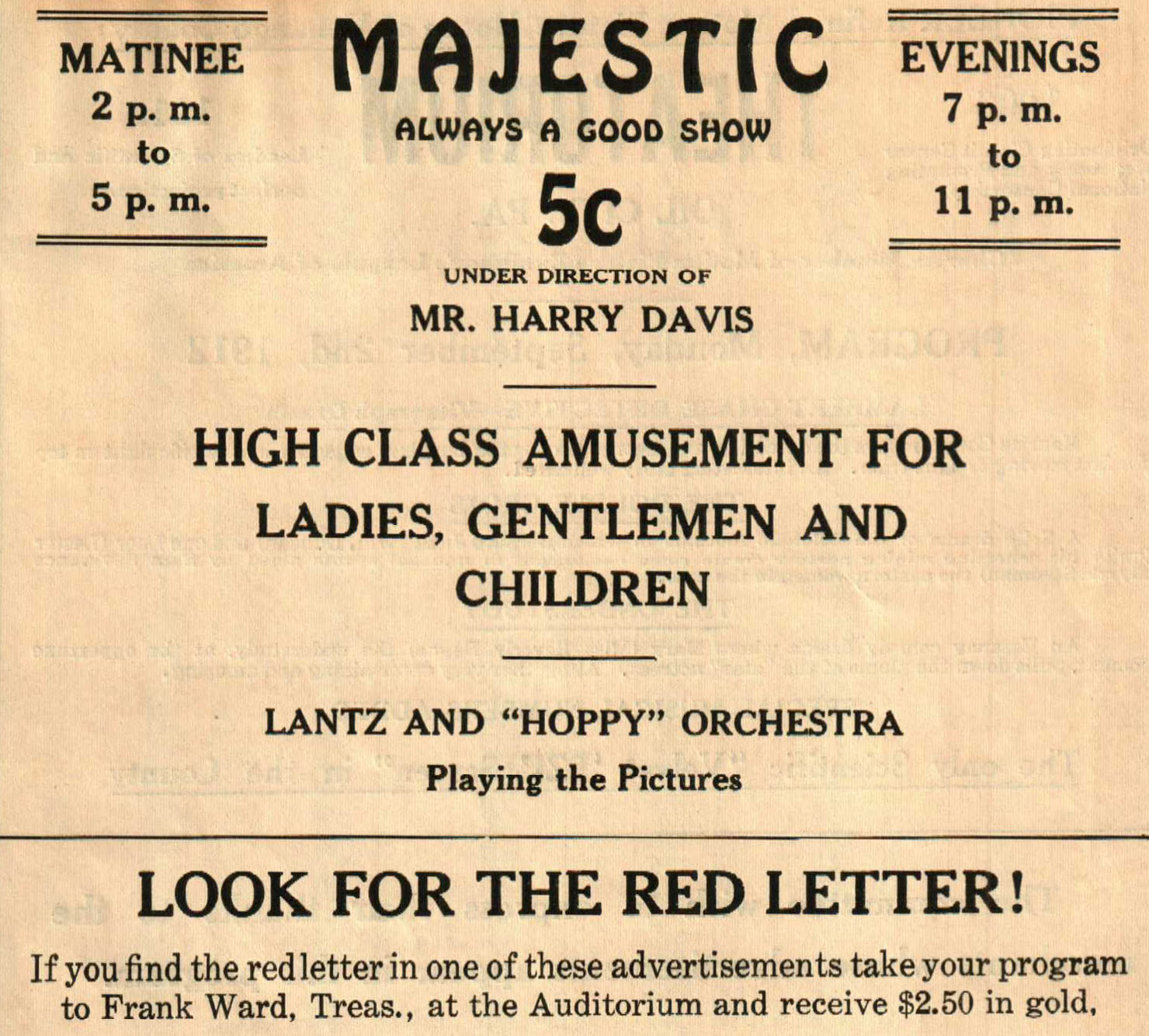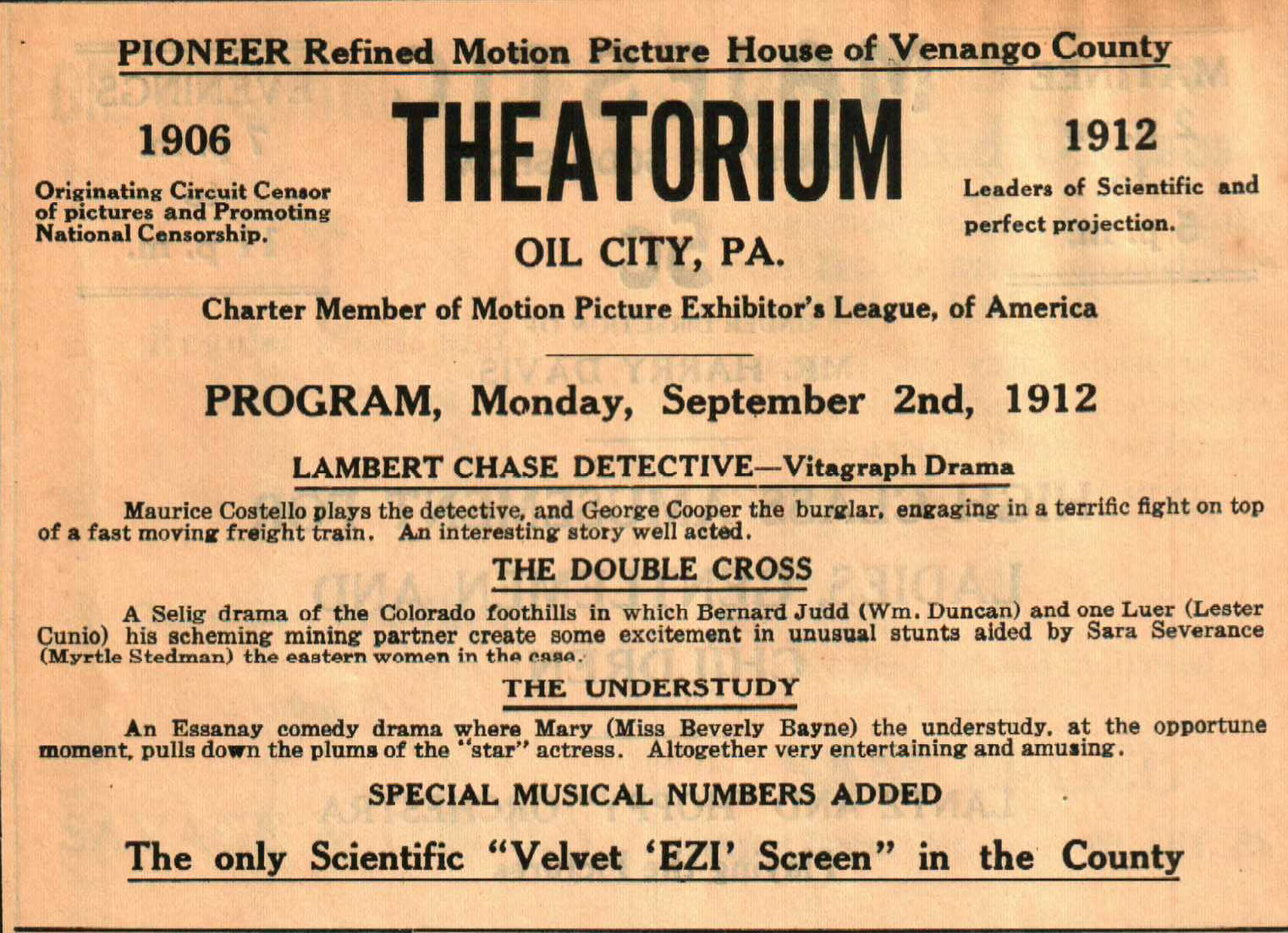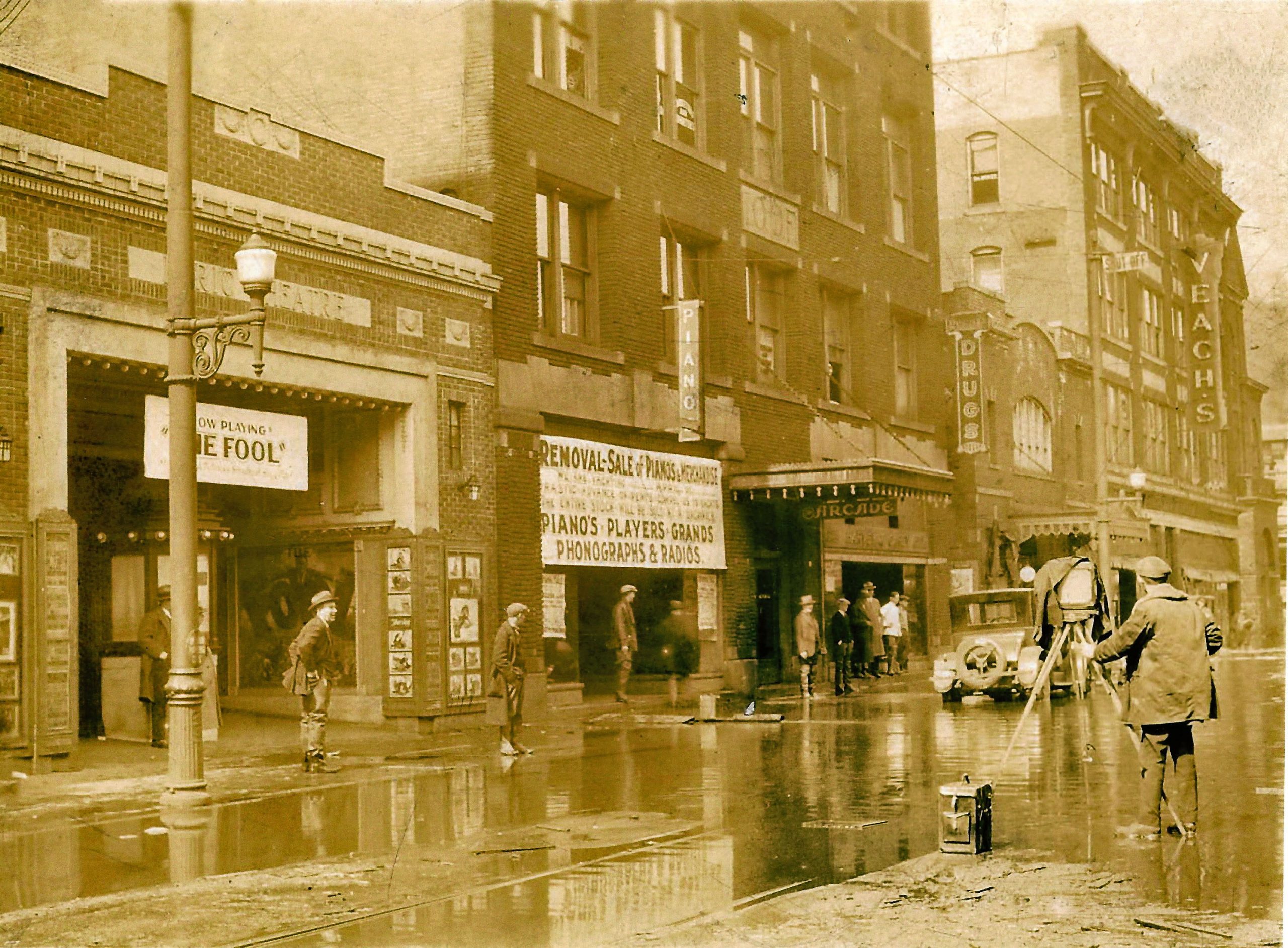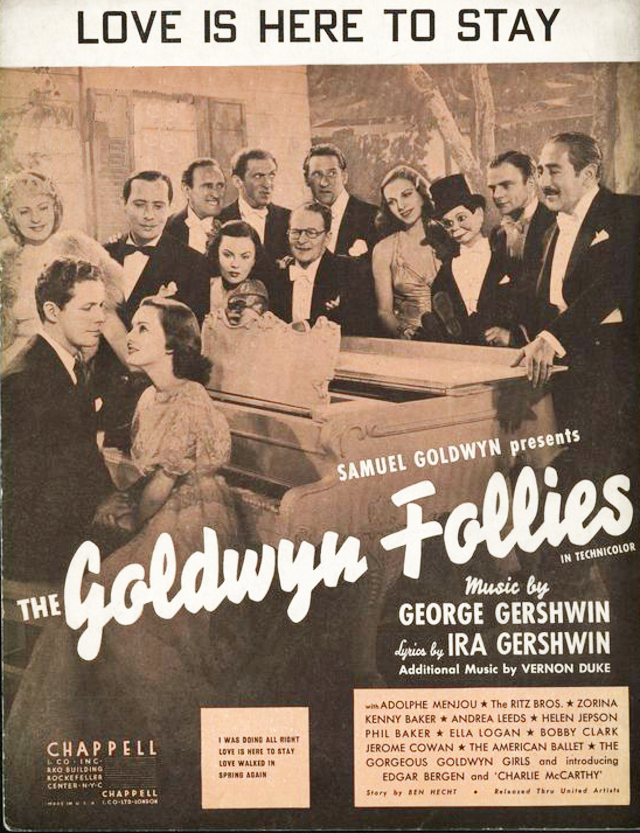Early Theaters
- Judy Etzel
- July 22, 2022
- Hidden Heritage
- 5823
Oil City boasted several theaters in its early history. Patrons could enjoy a wide variety of vaudeville acts, musical performances and moving pictures in a prosperous community that touted its cultural offerings. The theater spaces ranged from leased floors in a few buildings along Seneca Street to cavernous auditoriums replete with ornate decorations and state-of-the-art theater effects.
Taking top billings as theaters were two opulent, elegant and fully outfitted movie houses – the Latonia Theatre on the city’s South Side and the Col. Drake Theatre on the city’s North Side. They opened within a year of each other and soon dominated the regional theater scene.
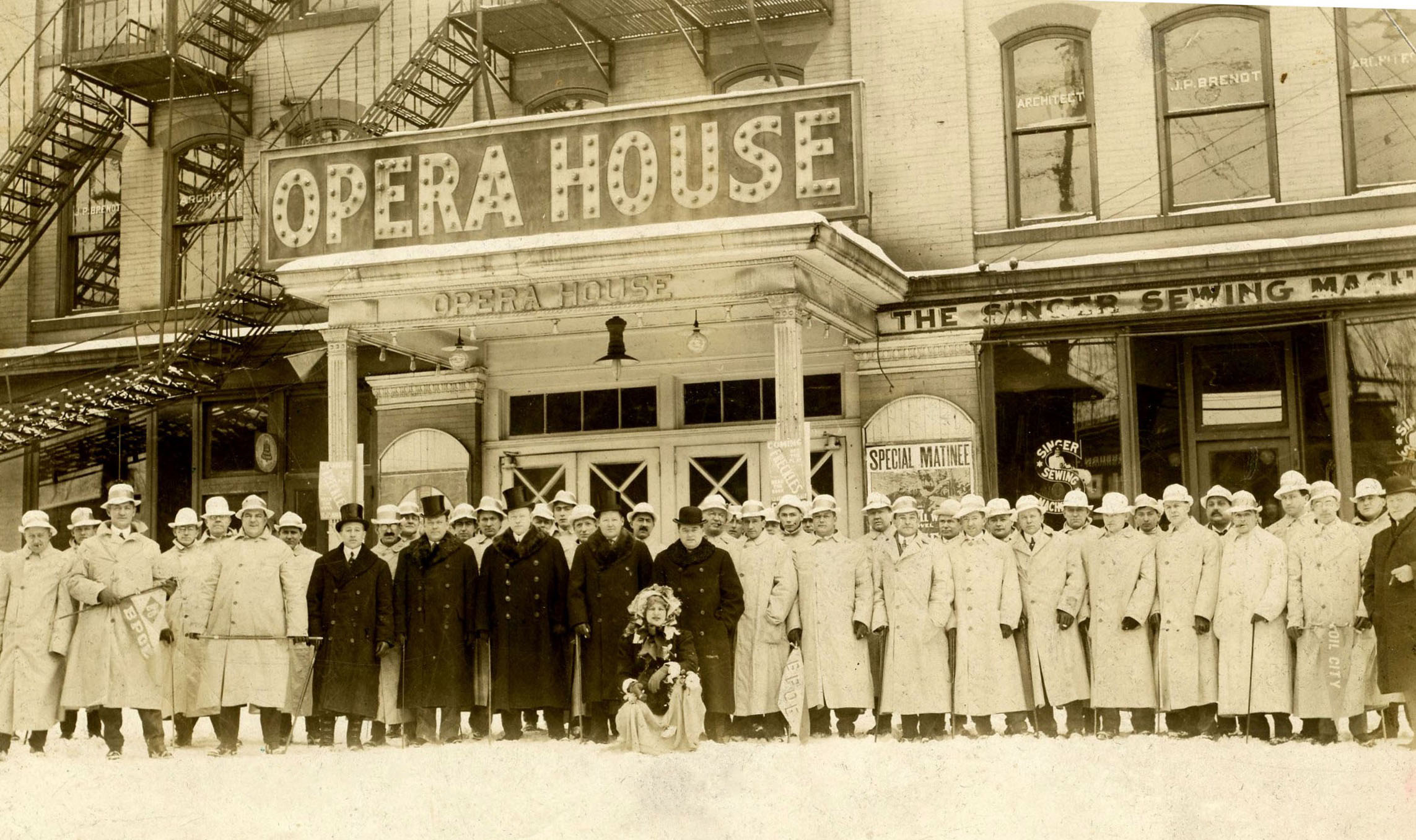
Col. Drake Theater
Billed as the city’s “premiere entertainment palace,” the Col. Drake Theatre opened with much fanfare on Aug. 27, 1928. The theater and adjacent office building occupied nine lots on Seneca Street.
The opening date for the theater was chosen to coincide with Col. Edwin Drake’s successful oil well near Titusville in 1859. One of the members of Drake’s drilling team, Samuel B. Smith, nephew of Billy Smith, manager of Drake’s drilling crew, joined in the laying of the theater cornerstone in January 1928.
Newspaper reports told of the vast amount of material required to build the $1 million three-story, gray brick and terra cotta theater and office complex. Some 237 railroad freight cars delivered brick, sand, boilers, chairs, marble, paint, a Wurlitzer organ, boards, and more to the site. That inventory did not include stage equipment, hardware, water pipe, and other building necessities. The brick building required 800 tons of steel for the infrastructure.
The Drake Theatre, built in what was described by the architects as the French style, boasted a capacity of about 2,000 persons and featured a large balcony, a fully equipped stage and orchestra pit, modern fire-proof construction, and a large lighted sign atop the ornate front entranceway. There were spacious lounges with French-imported furniture, telephone booths, drinking fountains, and more.
The theater project was launched by George Veach, founder and owner of Veach’s Furniture Store on Seneca Street. Veach was convinced Oil City was growing quickly and needed an outstanding entertainment center.
Vemark Theater Co., Veach’s newly formed theater management company, would operate the theater under a contract with Paramount Studios in California. Drake Realty, another Veach company, would own the theater and office building.
Opening night featured speakers, musical selections by the Drake Symphony Orchestra, a live musical stage show, an Our Gang comedy, a newsreel, a feature film, and three vaudeville acts.
Within months of the gala, the Col. Drake Theatre would face a formidable rival across town as the majestic Latonia Theatre opened.
Latonia Theatre
The Latonia Theatre got its name from the small settlement called Laytonia on the South Side. Joseph Lay, whose great uncle William L. Lay owned 63 acres on that side of the river in the 1860s, said his ancestor called the area Laytonia – Lay for the family name and tonia after his dog, Tonie.
The city’s South Side grew quickly and its prosperity enticed city residents, in concert with owners of a Pittsburgh theater chain, to propose the construction of a new and elegant movie and vaudeville house on East First Street. The chosen name was Latonia, a slight variation of the early village’s name.
Leading the effort was the South Side Business Men’s Association that sold stock to 100 local businesses and individuals to raise money for the project. L.O. Bouquin of Oil City was chosen as the builder. The entire carpeting for the theater was installed by Welker & Maxwell Co. across the street from the new theater. The Latonia, a towering yellow brick building adorned with sculpted figures along the roof line and a multi-story electrified sign out front, opened on March 4, 1929. The date was designed to coincide with the inauguration of Herbert Hoover as president. The gilt and marble interior, accented with a magnificent chandelier, sky dome, expansive stage, orchestra pit, large gilded peacock decorations, a Wurlitzer organ and more could hold 1,460 patrons.
The theater was successful for decades but ran into financial difficulties in the 1960s. On Nov. 30, 1969, two Walt Disney films were shown and the theater then shuttered.
Theaters Close
The Latonia and Drake stayed in business until the end of the 1960s when television, falling Hollywood studio support, and increasing expenses cut into the theaters’ profits. There were sporadic leases arranged with film providers but they could not sustain either theater for long.
The Latonia closed in 1969 and was later converted to a furniture store. It now houses a vintage book and antique store on the ground floor.
The Drake ceased its film and stage showings in June 1986. Despite efforts by a local theater group to keep it open, the theater was closed. The adjacent office building, though, remained full of tenants.
The property was purchased a few years ago by Webco Industries which was located next door. The office building and theater were then demolished to allow for the nearby plant to expand.
Earlier Theaters
Small theaters suitable for moving pictures as well as lavish vaudeville shows were plentiful in Oil City in the early 1900s. Most of the establishments were on Seneca Street.
However, the addresses changed often because of downtown building construction, the sale of properties, and opportunities to expand. In addition, the theater names frequently changed as new owners hustled to promote their theaters.
A key theater in the dozen or so that were doing business in the city was the Lyric Theater which is undergoing a current transformation by volunteers keen on re-establishing a functional theater.
On July 1, 1907, the Airdome Theater, located next to the National Transit Building on Seneca Street, held its grand opening. Less than three months later, it was renamed the Lyric. It eventually moved to the old Oil Exchange Building down the street but was not there for too long because that structure was demolished to make way for a new Oil City National Bank building.
There were a few more moves into earlier theater buildings, including the Cameo on Seneca Street, where the Lyric remained open until 1953. Two years later, the building was leased to clothiers Ray L. Way and Abe Lang who opened their shops there. The remodeling work was done by L.O. Bouquin of Oil City.
1910 through 1925 Oil City directories lists these downtown theaters, all on Seneca Street: Majestic, Temple, Theatorium, Princess, Venango, Cameo, New Lyric, Hippodrome, Star and Airdome. However, a few of those theaters changed names as well as locations in that interim and are one and the same. The reshuffling of theater sites, as well as a series of name changes, is confusing as to what theater was where and when. Research shows the Seneca Street location where the Lyric Theater project is underway was the site of a theater for decades. However, the marquee names included Airdome, Lyric, Orpheum, Princess, Cameo, and back to Lyric.
However, all the theaters heartily advertised their offerings and the advertising material offers up what they provided to local patrons.
The show offerings, according to advertisements from the theaters, included harp playing, athletes and their feats of strength, the world’s “greatest equilibrist,” animal acts, magicians, “illustrated songs,” orchestra music, comedians, dancers, mind readers, evangelists, and, of course, moving pictures.
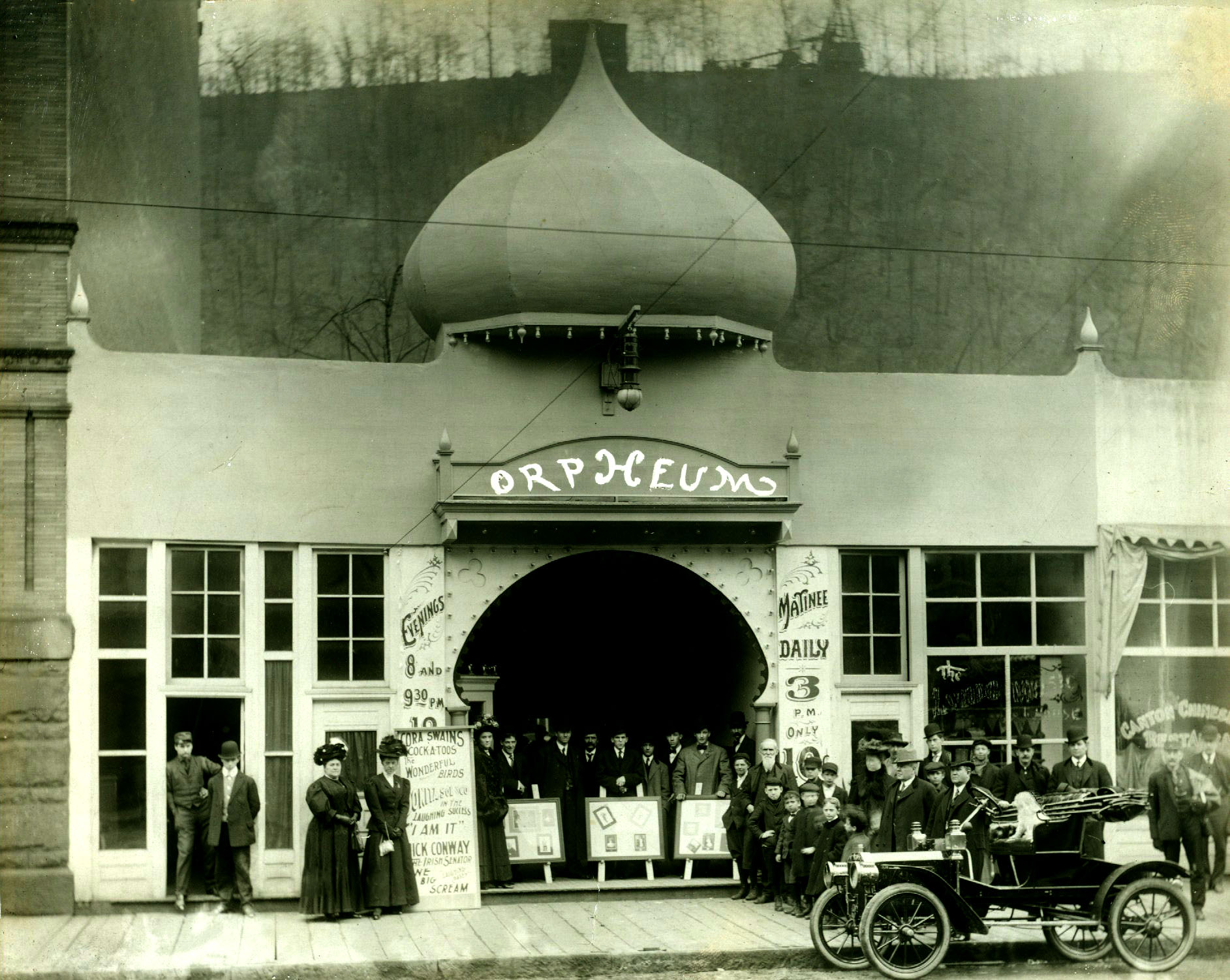
Here is a sampling:
- The Airdome, later renamed the Lyric, boasted these attractions during one 1907 playbill: champion club jugglers, moving pictures, a man “who played 10 novel music instruments” and Baby Thelma, “the youngest child in Vaudeville who sings, tells stories and does a wonderful whistling speciality.” Admission prices for any of the performances, offered six days a week, was 10 cents, 20 cents or 30 cents.
- An advertisement for a mid-1907 show at the Lyric offered Clint “Noodles” Fagan, “champion newsboy of the world, orator and globe trotter who never went to school a day in his life … but is a veritable graduate of the university of the world.” His programs included tales of his worldly excursions plus tips on how to sell newspapers. Fagan visited schools in the city and did “imitations with his starring act being one of the late President McKinley”. All newsboys working for The Blizzard newspaper were guests of honors at the Lyric shows and he joined them each evening to sell the newspapers in the city’s downtown streets.
- In 1908, the Orpheum Theater offered an unusual contest to patrons: it would give $500 in cash to “the man, woman or child who does not laugh at the Orpheum tonight” during a special vaudeville show.
- The Star Theater, billed as “the home of high class Vaudeville,” invited all firemen in town who were gathered for an October 1909 convention to “come in at any time, stay as long as you like” during the six days of live shows. “A visit to this theater will complete your merry time,” the theater promised.
- In 1910, the Plaza theater put this in its advertisement: “No waits. Steady clean pictures, good music, long entertainment. Courteous treatment is our motto.”
- In 1910, the Orpheum offered up its February and March lineup of entertainers. Appearing on stage would be “George A. Herz, champion bag puncher of the world, Eddie Addir and his Four Brunettes, Freeman and his wonderful trained goats, the Baader LaVelle Troupe of premiere acrobatic cyclists with Violet LaVelle, the lady in the act, being a first cousin of our late President McKinley.” The stage would also be occupied by Eddie Fox with his “eccentric singing, dancing, and Italian impersonations”, Gus Edwards’ Blond Typewriters and Johnny Jenkins the Laughologist with his imitations of great men.
- The Majestic Theater opened in October 1911. The local newspaper reported, “It is worthy of the refinement and culture that make Oil City so cosmopolitan in character and give it such a unique world-wide reputation.” The theater on Seneca Street was “erected at a time when money was no object” and the furnishings are “truly ornate.” A Majestic Theater notice described it “as the coolest spot in town.”
- One full page advertisement in the local newspaper in 1913 paid tribute to some of the theater managers. They included H.H. Potts of the Theatorium, F.S. Frazier at the Orpheum and F.N. McCullough at the Princess. As for McCullough, he was highlighted because he “brought the first feature picture ever shown in Oil City, ‘The Fall of Troy,’ a two-reeler” in 1909. The showing “created a furor in the city,” noted the article.
- In October 1919, the Venango Theater at 228 Seneca St., opened after an extensive $75,000 remodeling project. The theater could seat 700 on the first floor and another 260 people in the balcony. “It is Oil City’s largest and most elaborate motion picture house devoted exclusively to the reproduction of the highest class of film classics,” boasted an advertisement.
- In September 1925, the New Lyric Theater, displaced by the demolition of the Oil Exchange building, opened on the site formerly occupied by the Cameo Theater on Seneca Street. The manager was Herman Stahl, who had previously operated the Majestic Theater and would later be associated with the Latonia Theatre. The opening night at the 765-seat theater would feature “newly equipped motion picture machines, the latest and up to the minute flickerless machines.”
- The Venango Theater offered free tickets “to those find their names hidden among the ads in the Bi-Weekly Buyers and Shoppers Guide which appears in The Derrick every Monday and Thursday.
- A 1923 news article called attention to the sale by Mrs. J.J. Graham of the Venango Theater to Mike Marks. She and her late husband bought the Temple Theater in 1914 and then took over the nearby Venango Theater in 1922. “She raised the standard of the Venango to a high degree,” noted an item about the sale. “Architectural attractions were improved with the installation of flowers, songbirds, palms and other potted plants, a splendid orchestra, ideal courtesy and a high class of screen presentations.”
The Lyric Theater was the last of the smaller movie houses in Oil City to close. It shut down in 1953 and was converted to retail shops two years later. Meanwhile, the city boasted of its two major theaters – the Colonel Drake Theater and the Latonia Theater, for several more years.
DID YOU KNOW?
Helen Jepson, a Metropolitan opera star, was born in 1904 in Titusville but raised in Akron, Ohio. Described as a “stunningly attractive blond lyric soprano, Jepson sang with the Paul Whitman Orchestra and had a successful radio career.
She took on a major role with the Metropolitan Opera in New York City in 1935 and went on to be their leading soprano. She had one film role and that was in the 1938 production of the “Goldwyn Follies.”
When she developed vocal cord problems, Jepson went to college and earned a degree in speech therapy. She became a therapist and music teacher.
Jepson died in 1997 in Florida.
Written by Judy Etzel with research by Kay Dawson and design by Natalie Cubbon.
HIDDEN HERITAGE IS SPONSORED BY:
Oil Region Alliance
Gates & Burns Realty
Support This Project
Donations to the library are appreciated to help offset printing costs & make this project possible! Want to become a sponsor? Email us at promotions@oilregionlibraries.org to get started!
Make a Donation
